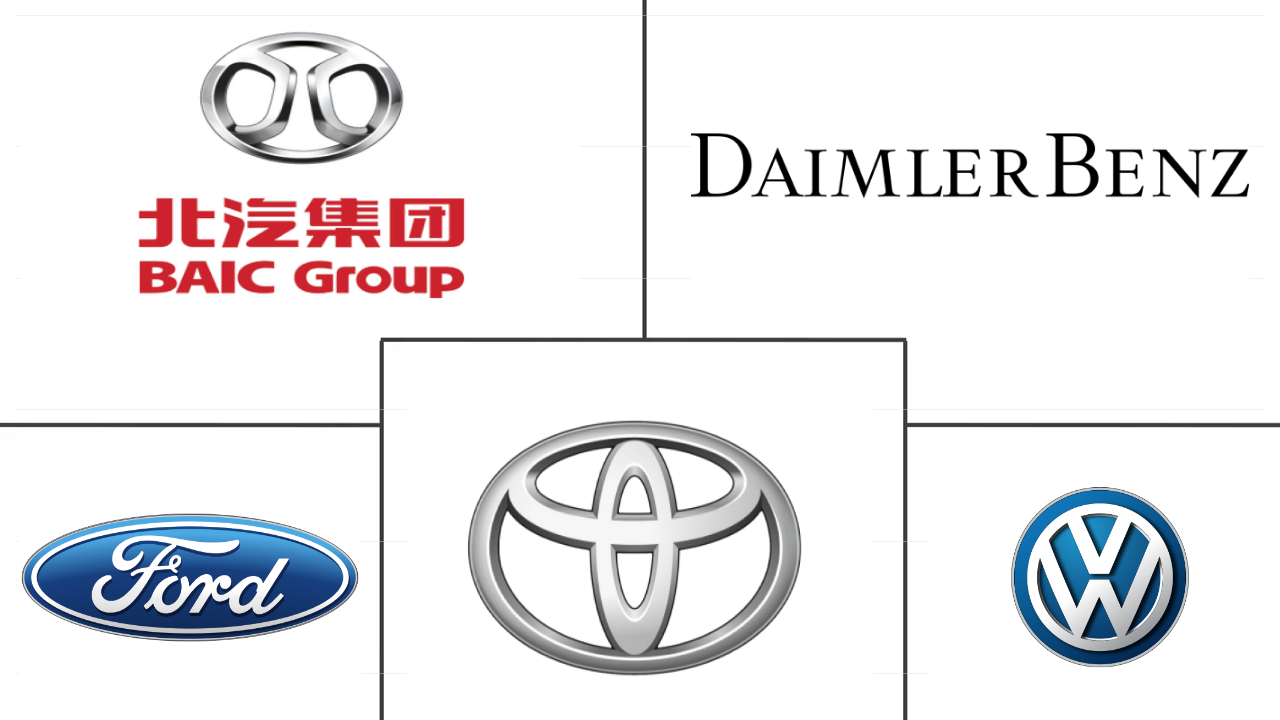Market Size of commercial vehicles Industry
|
|
Study Period | 2017 - 2030 |
|
|
Market Size (2024) | USD 0.85 Trillion |
|
|
Market Size (2030) | USD 1.33 Trillion |
|
|
Largest Share by Vehicle Body Type | Light Commercial Pick-up Trucks |
|
|
CAGR (2024 - 2030) | 7.83 % |
|
|
Largest Share by Region | Asia-Pacific |
Major Players |
||

|
||
|
*Disclaimer: Major Players sorted in no particular order |
Commercial Vehicles Market Analysis
The Commercial Vehicles Market size is estimated at 0.85 trillion USD in 2024, and is expected to reach 1.33 trillion USD by 2030, growing at a CAGR of 7.83% during the forecast period (2024-2030).
0.85 Trillion
Market Size in 2024 (USD)
1.33 Trillion
Market Size in 2030 (USD)
2.23 %
CAGR (2017-2023)
7.83 %
CAGR (2024-2030)
Largest Segment by Vehicle Configuration
51.45 %
value share, Trucks, 2023
Trucks dominate the global commercial vehicle market due to their critical role in logistics and transportation, meeting the high demand for goods movement across various industries.
Largest Segment by Fuel Category
53.55 %
value share, Diesel, 2023
Diesel remains the largest segment due to its higher energy density and better fuel efficiency for long-haul transportation, making it a cost-effective choice for commercial operations.
Fastest-growing Segment by Fuel Category
32.99 %
Projected CAGR, FCEV, 2024-2030
FCEVs are the fastest-growing segment due to advancements in hydrogen fuel cell technology, expanding infrastructure, and the global push for zero-emission vehicles.
Largest Country Market
28.09 %
value share, China, 2023
China leads the global commercial vehicle market due to its extensive manufacturing base, significant domestic demand, and investments in vehicle technology and infrastructure.
Leading Market Player
12 %
market share, Ford Motor Company, 2023

Ford leads due to its versatile commercial vehicles, global brand reputation, and extensive dealership network, making it a top choice worldwide.
- The development of the industrial sector in emerging economies and the increase of commercial logistics activities substantially impact the demand for commercial vehicles. Due to the growing demand for material transportation caused by the developing construction and e-commerce industries, commercial vehicle sales have recently grown. After declining by three million units in 2020, the output of commercial vehicles increased to roughly 23.2 million units in 2021, steadily regaining its previous level.
- As the majority of international borders are closed due to the COVID-19 pandemic, the commercial vehicle manufacturing industry's supply chain is expected to be disrupted for an extended period in 2021. This will have a negative impact on market growth. The COVID-19 pandemic brought the transportation sector to a halt, posing significant challenges for the freight and manufacturing industries in moving goods from one location to another.
- Due to increased demand for commercial vehicles, truck manufacturers have been introducing new advanced trucks to meet the rising demand and emission standards. Commercial vehicle leasing and the rental industry are also growing due to the increased demand for operational efficiencies and the realization of economies of scale by businesses across multiple industries. E-commerce has become an essential component of the global retail framework in recent years. Over 2 billion people purchased goods or services online in 2020, and global e-commerce sales surpassed USD 4.2 trillion in the same year. The overall commercial vehicle industry is expected to grow significantly in the near future.
- Commercial vehicle manufacturing grew to about 23.2 million units globally in 2021 after declining by 3 million units in 2020. Light commercial vehicles are sometimes defined as automobiles weighing less than 3.5 ton. A commercial vehicle is any motor vehicle intended for use in the commercial transportation of products and people. With a total of 10.9 million vehicles manufactured in 2021, North America produced the most commercial vehicles. With close to 3.3 million units manufactured, estimates ranked Asia and Oceania as the world's greatest producers of heavy trucks in 2021. One of the key drivers fueling the market's expansion is a rise in clean energy demand in the automobile sector.
- The global output of commercial vehicles decreased by little about 13% between 2019 and 2020 before increasing again in 2021. Manufacturing facilities were shut down amid national lockdowns that extended until 2020 because of the coronavirus pandemic's effects on the transportation and logistics sector. While demand and output rose in 2021, the sector's recovery was hindered by the worldwide chip shortage, which led factories to once again cut back on output.
- Due to the increased public concern over the carbon dioxide emissions of the international transportation sector, finding alternative fuel sources is now a more important goal for the commercial fleet sector. Governments all across the world have taken the lead in enacting laws and rules to encourage the use of electric vehicles. According to their individual pronouncements, China, India, France, and the United Kingdom will stop producing gasoline and diesel vehicles by 2040. This transition will increase the penetration of commercial vehicles in the near future.
Commercial Vehicles Industry Segmentation
Commercial Vehicles are covered as segments by Vehicle Type. Hybrid and Electric Vehicles, ICE are covered as segments by Propulsion Type. Africa, Asia-Pacific, Europe, Middle East, North America, South America are covered as segments by Region.
- The development of the industrial sector in emerging economies and the increase of commercial logistics activities substantially impact the demand for commercial vehicles. Due to the growing demand for material transportation caused by the developing construction and e-commerce industries, commercial vehicle sales have recently grown. After declining by three million units in 2020, the output of commercial vehicles increased to roughly 23.2 million units in 2021, steadily regaining its previous level.
- As the majority of international borders are closed due to the COVID-19 pandemic, the commercial vehicle manufacturing industry's supply chain is expected to be disrupted for an extended period in 2021. This will have a negative impact on market growth. The COVID-19 pandemic brought the transportation sector to a halt, posing significant challenges for the freight and manufacturing industries in moving goods from one location to another.
- Due to increased demand for commercial vehicles, truck manufacturers have been introducing new advanced trucks to meet the rising demand and emission standards. Commercial vehicle leasing and the rental industry are also growing due to the increased demand for operational efficiencies and the realization of economies of scale by businesses across multiple industries. E-commerce has become an essential component of the global retail framework in recent years. Over 2 billion people purchased goods or services online in 2020, and global e-commerce sales surpassed USD 4.2 trillion in the same year. The overall commercial vehicle industry is expected to grow significantly in the near future.
| Vehicle Type | ||||||
|
| Propulsion Type | ||||||||
| ||||||||
|
| Region | |||||||||||
| Africa | |||||||||||
| |||||||||||
| |||||||||||
| Middle East | |||||||||||
| |||||||||||
| South America |
Commercial Vehicles Market Size Summary
The commercial vehicles market is poised for significant growth, driven by the expansion of the industrial sector in emerging economies and the increasing activities in commercial logistics. The demand for commercial vehicles has been bolstered by the burgeoning construction and e-commerce industries, which have necessitated greater material transportation. Despite challenges posed by the COVID-19 pandemic, such as supply chain disruptions and a temporary decline in vehicle output, the market has shown resilience and is expected to continue its upward trajectory. The introduction of advanced trucks and the growth of the commercial vehicle leasing and rental industry are further indicative of the market's expansion. The shift towards electric vehicles, spurred by environmental concerns and government regulations, is also a key factor influencing the market dynamics.
The global commercial vehicles market is characterized by a fragmented landscape, with major players like BAIC Motor Corporation Ltd., Daimler AG, Ford Motor Company, Toyota Motor Corporation, and Volkswagen AG holding significant shares. The market's growth is further supported by advancements in battery technology and vehicle electrification, particularly in the Asia-Pacific and European regions. Companies like Kia Motors are actively pursuing electrification strategies, aiming to enhance their electric vehicle offerings. The transition towards electric vehicles is expected to accelerate, with projections indicating a substantial increase in EV sales. This shift is not only a response to regulatory pressures but also aligns with the broader industry trend towards sustainability and energy efficiency.
Commercial Vehicles Market Size - Table of Contents
-
1. MARKET SEGMENTATION (includes market size in Value in USD and Volume, Forecasts up to 2030 and analysis of growth prospects)
-
1.1 Vehicle Type
-
1.1.1 Commercial Vehicles
-
1.1.1.1 Heavy-duty Commercial Trucks
-
1.1.1.2 Light Commercial Pick-up Trucks
-
1.1.1.3 Light Commercial Vans
-
1.1.1.4 Medium-duty Commercial Trucks
-
-
-
1.2 Propulsion Type
-
1.2.1 Hybrid and Electric Vehicles
-
1.2.1.1 By Fuel Category
-
1.2.1.1.1 BEV
-
1.2.1.1.2 FCEV
-
1.2.1.1.3 HEV
-
1.2.1.1.4 PHEV
-
-
-
1.2.2 ICE
-
1.2.2.1 By Fuel Category
-
1.2.2.1.1 CNG
-
1.2.2.1.2 Diesel
-
1.2.2.1.3 Gasoline
-
1.2.2.1.4 LPG
-
-
-
-
1.3 Region
-
1.3.1 Africa
-
1.3.2 Asia-Pacific
-
1.3.2.1 Australia
-
1.3.2.2 China
-
1.3.2.3 India
-
1.3.2.4 Indonesia
-
1.3.2.5 Japan
-
1.3.2.6 Malaysia
-
1.3.2.7 South Korea
-
1.3.2.8 Thailand
-
1.3.2.9 Rest-of-APAC
-
-
1.3.3 Europe
-
1.3.3.1 Czech Republic
-
-
1.3.4 Middle East
-
1.3.5 North America
-
1.3.5.1 Canada
-
-
1.3.6 South America
-
-
Commercial Vehicles Market Size FAQs
How big is the Global Commercial Vehicles Market?
The Global Commercial Vehicles Market size is expected to reach USD 845.64 billion in 2024 and grow at a CAGR of 7.83% to reach USD 1329.05 billion by 2030.
What is the current Global Commercial Vehicles Market size?
In 2024, the Global Commercial Vehicles Market size is expected to reach USD 845.64 billion.

